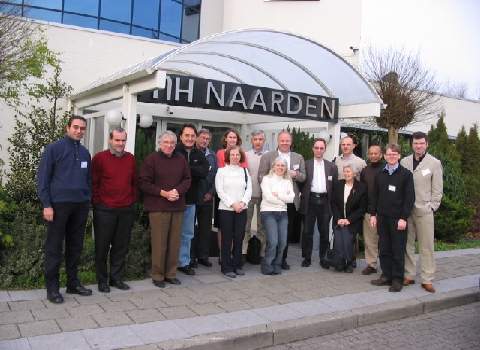Inducing muscle hypertrophy as a therapeutic strategy for muscular dystrophies
- Number 122
- Date 28 November 2003
Eighteen participants from 5 countries (France, Germany, Italy, UK and USA) participated in an ENMC workshop on the topic of "Inducing muscle hypertrophy as a therapeutic strategy for muscular dystrophies".
Muscle atrophy is observed both in muscular dystrophies and aging. Numerous approaches have been demonstrated to induce muscle hypertrophy that could be used as a mean to reverse muscle atrophy. This workshop brought together scientists and clinicians working on cellular and molecular aspects of this process that could be exploited as a treatment for these muscle wasting conditions.
Four aspects were discussed in detail. The first topic concentrated on cellular aspects of muscle hypertrophy and in particular on the role of satellite cells. Satellite cells are a reservoir of precursors that lay in a dormant state in muscle and are recruited during phases of muscle growth and to repair damaged tissue. An important new concept to emerge from this meeting was that not all satellite cells are able to participate to the muscle regeneration. This raises the possibility of isolating those cells which are particularly able to participate to the regeneration process. In addition, evidence was presented that the efficiency of satellite cells recruitment can differ in different neuromuscular conditions. A new therapeutic avenue was presented raising the possibility of using cells other than satellite cells as a mean of addressing muscle atrophy. In particular cells from the circulatory system were shown to be able to cross the capillary bed into muscle and participate in muscle growth and repair of an animal model of muscular dystrophy.
The second topic concentrated on the mechanism by which muscles enlarge and how they undergo atrophy. Work was presented that showed that the two processes are linked by a molecule, called Akt that not only regulates protein synthesis, but also inhibits molecules involved in protein breakdown (atrofin-1 and FOXO). The role that this pathway plays in a number of conditions characterized by muscle atrophy will now have to be explored.
The third topic concentrated on secreted factors that regulate muscle growth. Particular attention was paid to a molecule called IGF-1 and similar proteins that were shown to induce muscle hypertrophy. A variant of one of these was shown to play a significant role in muscle growth following exercise.
The last session concentrated on the novel discovery of a factor that prevents muscle development, myostatin. Gene targeting that removes this protein showed massive increase in muscle formation. Strategies were discussed aimed at developing molecules that would antagonize the function of this protein as a therapeutic means to address muscle wasting. Similarities were drawn between the development of muscle during embryonic and adult life and the role of myostatin.
A discussion consolidated the four topics in this workshop and brought together the molecules and mechanisms by which muscle atrophy develops and how can be alleviate. Collaborative strategies were set up to evaluate these hypothesis.
An extended report of this meeting has been published in Neuromuscular Disorders. To access the full report, please click here.
Prof. Francesco Muntoni and Dr. Ketan Patel, London, UK

ENMC
Lt. generaal van Heutszlaan 6
3743 JN BAARN
The Netherlands
+ 31- 35-5480481
enmc@enmc.org
We may request cookies to be set on your device. We use cookies to let us know when you visit our websites, how you interact with us, to enrich your user experience, and to customize your relationship with our website.
Click on the different category headings to find out more. You can also change some of your preferences. Note that blocking some types of cookies may impact your experience on our websites and the services we are able to offer.
These cookies are strictly necessary to provide you with services available through our website and to use some of its features.
Because these cookies are strictly necessary to deliver the website, refusing them will have impact how our site functions. You always can block or delete cookies by changing your browser settings and force blocking all cookies on this website. But this will always prompt you to accept/refuse cookies when revisiting our site.
We fully respect if you want to refuse cookies but to avoid asking you again and again kindly allow us to store a cookie for that. You are free to opt out any time or opt in for other cookies to get a better experience. If you refuse cookies we will remove all set cookies in our domain.
We provide you with a list of stored cookies on your computer in our domain so you can check what we stored. Due to security reasons we are not able to show or modify cookies from other domains. You can check these in your browser security settings.
These cookies collect information that is used either in aggregate form to help us understand how our website is being used or how effective our marketing campaigns are, or to help us customize our website and application for you in order to enhance your experience.
If you do not want that we track your visit to our site you can disable tracking in your browser here:
We also use different external services like Google Webfonts, Google Maps, and external Video providers. Since these providers may collect personal data like your IP address we allow you to block them here. Please be aware that this might heavily reduce the functionality and appearance of our site. Changes will take effect once you reload the page.
Google Webfont Settings:
Google Map Settings:
Google reCaptcha Settings:
Vimeo and Youtube video embeds:
The following cookies are also needed - You can choose if you want to allow them:
You can read about our cookies and privacy settings in detail on our Privacy Policy Page.
Privacy Policy